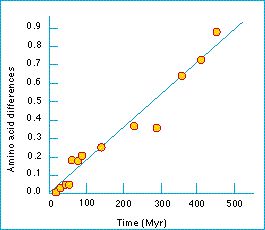Molecular clock

Observations about amino acid changes that occurred during the divergence between species, show that molecular evolution takes place at an approximately constant rate. Further evidence for this came from the relative rate test. This suggests that molecular evolution is constant enough to provide a molecular clock of evolution. This means that the amount of molecular change between two species measures how long ago they shared a common ancestor. Molecular differences between species are therefore used to infer phylogenetic relations.
Molecular evolution in living fossils provides an example of a constant rate of molecular evolution independent from morphologic evolution.
Figure: the constant rate of evolution of the alpha-globin. Each point on the graph is for a pair of species, or groups of species.
Does neutral drift explain the molecular clock?
| Next |



